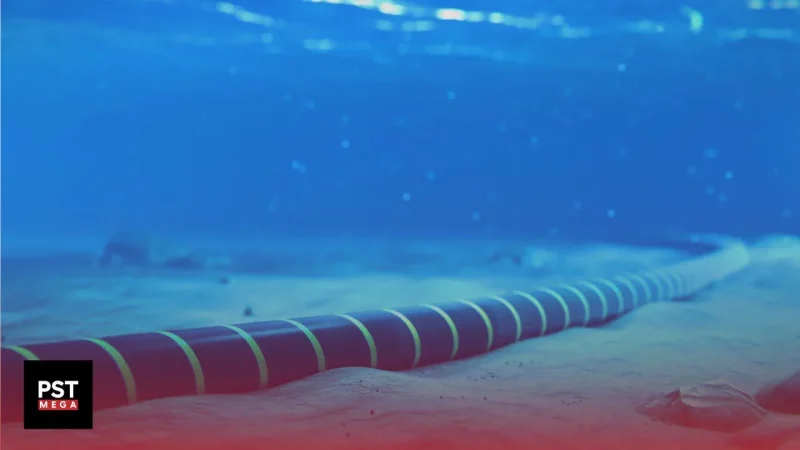We are so used to internet Wi-Fi these days that we forget that the wireless services that we get are at the end of the day connected to cables running all over the world. Most of these cables are underwater. In fact, as of today, the total length of cables lying at the bottom of the world’s oceans is approximately 1.2 million kilometers. These cables can withstand the harsh sea environment and require massive and complicated tools in order to be built and transported to the deep waters.
How Cables Are Protected
The first point that deserves attention is how cables remain intact for years even though they literally lie at the bottom of the ocean. One might think that these cables are encased in layers upon layers of protective material, but, surprisingly, this is not the case: the cables are actually not thicker than a stick of glue. Nevertheless, they are of course encased in steel tubing that is generally enough for protection despite not being very thick.
This is not to say that it is not possible for cables to be damaged. Quite the contrary: years of research go into finding the best and safest ocean beds for laying an internet cable. A lot of factors have to be taken into consideration. For example, active volcanic areas or locations particularly prone to earthquakes and mudslides are obviously not safe for cables. Imagine the amount of geological and geographical research needed to determine whether an area is good or not in that regard.
On top of that, natural disasters are not the only facts to be accounted for; there’s also the threat of human error. From time to time, some ship anchors or construction equipment will damage an underwater cable. This is why it’s important for cables to be far from areas where fishermen, for instance, are active.
But even if one accounts for the possibility of human error, the behavior of sea creatures remains unpredictable, and they can be dangerous. Sharks have been known to damage internet cables, though the exact reason for this behavior is unknown. It’s possible that something having to do with electromagnetic waves attracts them, or maybe they are just curious. In any case, shark attacks only account for less than 1% of cables in history. As far as most sea creatures are concerned, a cable is just another rock lying at the ocean bed. Still, companies like Google aren’t taking any chances; they protect their cables with shark-proof wrappers.
How the Internet Dives into the Ocean
Setting aside the issue of planning the location and route for the cable, it is even more interesting to see how they are actually built and laid on the ocean floor. A lot depends on the length of the cable, which can lie anywhere between 300 kilometers and more than 37,000 kilometers in some cases. As a case study, let’s take a look at Google’s recent massive project of laying a cable that is around 4,000 miles long, and weighs roughly 3,500 metric tons, which is equivalent to the combined weight of 20 blue whales. The goal of the project is to connect the United States to Chile, which houses the company’s largest data center.
During the manufacturing process, the cables pass through large mills, comparable in size to jet engines, at high speeds. These mills encase the wire in a copper casing, which facilitates the transmission of electricity to keep the data flowing. When finished, the cables end up the size of a thick garden hose, and the transportation process begins.
The cable is loaded into a huge ship designed to property store the cable and carry its crushing weight. Inside the ship, workers carefully wind the cable into large cavern-looking tanks. One worker walks in a circular motion, unspooling the cable much like laying out a massive garden hose, while others lie down to secure it and prevent any entanglements or knots. Despite continuous team efforts, it typically takes approximately four weeks for the ship to be fully loaded with enough cable before embarking on its journey across the open sea.
Finally, the ship travels down the pre-planned route, laying the cable bit by bit along the way. The cable is loaded into a cylindrical drum and is then slowly and carefully laid out. Depending on the environmental circumstances, some cables will be closer to the surface, while others eventually rest deep down at the bottom of the ocean. This also matters when it comes down to fixing damaged parts. If the cable is closer to the surface, divers will be sent to figure out the problem and fix it, but if the cable is at the bottom, the only way to fix it is to use some kind of anchor to pull it up and fix it on the surface.
Clearly, it’s cheaper to send divers to handle issues, but it can also be dangerous, as the immensely powerful electricity running through the cable can kill divers almost instantly if anything goes wrong. Nevertheless, the fact that some internet cables are within the reach of divers makes them vulnerable, as they can be interfered with. For example, a few years ago a group of men in wetsuits intentionally cut an internet cable off the coast of Alexandria in Egypt. The cable connected three continents: Europe, Africa and Asia, running over 12,500 miles. Until it could be repaired, internet speeds in Egypt were down by 60%.
Who Funds The Internet?
Overall, an internet cable can cost billions of dollars. The cost of Google’s previously mentioned project is estimated to be a total of $350 million. This is what a 6,500 kilometer cable costs, so imagine what it takes to build and transport a 37,000 kilometer one, as in the case of 2Africa, a project to connect tens of countries in Africa and the middle east. This is not to mention the obvious costs of maintaining and replacing these cables when necessary. In general, an internet cable is supposed to remain operational for approximately 25 years.
By now it’s obvious that internet infrastructure is an expensive business that requires lots of resources. Typically, the funding for this industry comes from governments or telecommunications giants like America’s AT&T, which owns more than 230,000 kilometers of internet cable, making it the world’s largest internet cable owner by far. In second place comes China Telecom.
It is also often the case that such projects are the result of collaborations between several countries and companies. 2Africa is a collaboration between Orange, China Telecom, Meta, and many other companies.
Recently however, tech giants have been increasingly involved in this industry. Meta, to mention one company, now owns over 100,000 kilometers of cable. Amazon and Google, too, have been quickly expanding their network of underwater cables, as is evidenced by Google’s US-to-Chile cable project. This rising demand for cable is largely due to the development of new technologies that require intensive computing power and a huge storage capacity; which in turn require gigantic data centers and the ability to connect them to each other across the globe.
AI & the Future Need for Expansion
These technologies are, unsurprisingly, mainly cloud computing and AI-based tools, like ChatGPT. Most people might mistakenly think that the increasing number of internet cables can be explained by the rising demand for faster wider access to the internet, but the real reason doesn’t actually have to do with your access to the internet as a consumer; it is generally about how tech giants can keep on improving the services they provide to their users.
Consider the case of ChatGPT, for instance. Millions of people make use of it every day. But even one request to ChatGPT requires a lot of computing power and searching through tons of data to produce a well-structured response. To provide such a service to millions of people simultaneously, you need advanced data centers and huge servers that can support computing power of this scale. The same goes for YouTube, which stores hundreds of millions of videos and has to provide millions of users with access to them at the same time.
No wonder that, given the rising number of new intensive-computing technologies combined with the increasing number of internet users worldwide, tech companies don’t want to be bottlenecked by the existing infrastructure. We can only expect the network of ocean cables to grow in the near future.
What about wireless satellite-based internet services? This is, after all, doable, since Elon Musk’s Starlink is an example that’s been proven to work. This raises the question of whether companies are unable to replace underwear cable with futuristic satellite technology.
While underwater cables are by no means cheap, they remain the fastest and cheapest method of data transfer available. It is unknown how things might change in a few decades; it’s possible that we’ll learn a trick or two to make satellite internet much cheaper, but until then, cables will continue to be a more efficient option compared to the extremely complicated and expensive task of building and launching a satellite. Elon Musk himself has said that Starlink is primarily intended for those who don’t have access to cable internet. For the foreseeable future, internet cables are the way to go.
Disclaimer
Please visit and read our disclaimer here.









